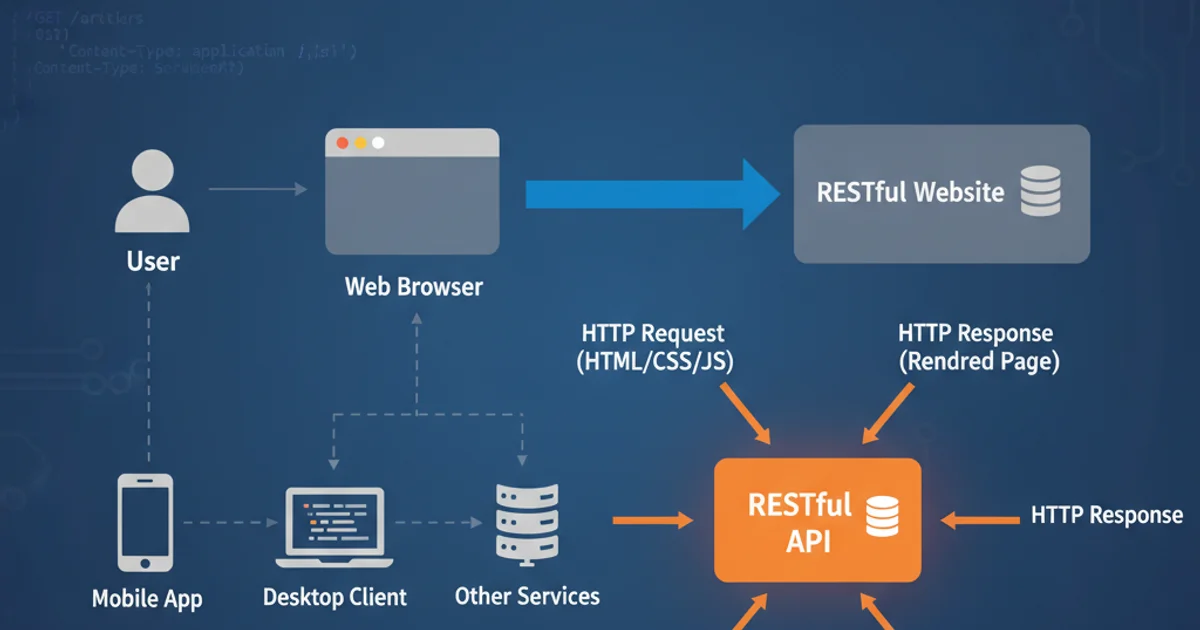RESTful websites vs. RESTful APIs - What's the difference and does it matter?
Categories:
RESTful Websites vs. RESTful APIs: Understanding the Core Differences

Explore the fundamental distinctions between RESTful websites and RESTful APIs, and why these differences are crucial for modern web development and system design.
In the world of web development, the terms "RESTful website" and "RESTful API" are often used interchangeably, leading to confusion. While both leverage the principles of Representational State Transfer (REST), their primary purposes, interaction patterns, and target audiences differ significantly. Understanding these distinctions is vital for designing efficient, scalable, and maintainable web applications and services.
What is REST?
Before diving into the differences, let's briefly recap REST. REST is an architectural style for distributed hypermedia systems. It defines a set of constraints that, when applied, yield a system with desirable properties like scalability, performance, and reliability. Key principles include:
- Client-Server Architecture: Separation of concerns between client and server.
- Statelessness: Each request from client to server must contain all the information needed to understand the request.
- Cacheability: Responses must explicitly or implicitly define themselves as cacheable or non-cacheable.
- Layered System: A client cannot ordinarily tell whether it is connected directly to the end server, or to an intermediary.
- Uniform Interface: Simplifies the overall system architecture and improves visibility of interactions.
- Code-On-Demand (Optional): Servers can temporarily extend or customize the functionality of a client by transferring executable code.
RESTful Websites: Human-Centric Interaction
A RESTful website, often built using frameworks like Ruby on Rails, is primarily designed for human interaction through a web browser. Its main goal is to serve HTML pages that users can navigate, read, and interact with. While it adheres to REST principles, the 'representation' it typically serves is a fully rendered web page.
Key characteristics of a RESTful website:
- Primary Output: HTML, CSS, JavaScript for rendering in a browser.
- Client: Web browser.
- Interaction: User clicks links, submits forms, navigates pages.
- State Transfer: The server sends a new HTML page (a new 'state') with each navigation or action.
- Self-Descriptive Messages: HTML forms and links often contain the necessary information (e.g., HTTP methods, URLs) for the browser to interact with the server.
- Hypermedia As The Engine Of Application State (HATEOAS): Often implicitly present, as links within HTML guide the user through the application's state transitions.
flowchart TD
A[User] --> B[Web Browser]
B -->|GET /products| C[RESTful Website (Server)]
C -->|Returns HTML (Product List)| B
B -->|User Clicks 'Add to Cart'| C
C -->|POST /cart/add| B
C -->|Returns HTML (Cart Page)| BInteraction flow for a typical RESTful website.
RESTful APIs: Machine-Centric Data Exchange
A RESTful API (Application Programming Interface), on the other hand, is designed for programmatic interaction between different software systems. Its primary purpose is to expose data and functionality in a structured, machine-readable format, typically JSON or XML. APIs serve as the backbone for single-page applications (SPAs), mobile apps, and integrations between various services.
Key characteristics of a RESTful API:
- Primary Output: JSON, XML, or other structured data formats.
- Client: Mobile apps, SPAs (e.g., React, Angular, Vue.js), other backend services, IoT devices.
- Interaction: Programmatic requests (HTTP methods like GET, POST, PUT, DELETE) to specific endpoints.
- State Transfer: Data is exchanged, and the client application is responsible for rendering and managing its own UI state.
- Self-Descriptive Messages: HTTP headers, status codes, and the structured data payload itself provide context.
- HATEOAS: While beneficial, it's often less strictly implemented in practice for APIs compared to websites, though it's a core REST principle.
sequenceDiagram
Client->>API Server: GET /users/123
API Server-->>Client: HTTP 200 OK, JSON { "id": 123, "name": "Alice" }
Client->>API Server: POST /users, JSON { "name": "Bob" }
API Server-->>Client: HTTP 201 Created, JSON { "id": 456, "name": "Bob" }
Client->>API Server: DELETE /users/123
API Server-->>Client: HTTP 204 No ContentSequence of interactions with a RESTful API.
Does the Difference Matter?
Absolutely! The distinction is crucial for several reasons:
- Client Expectations: A web browser expects HTML; a mobile app expects JSON. Serving the wrong format leads to broken experiences.
- Development Focus: Building a RESTful website involves UI/UX design, templating engines, and server-side rendering. Building a RESTful API focuses on data modeling, endpoint design, authentication, and efficient data serialization.
- Scalability & Performance: APIs are often designed for high-volume, low-latency data exchange, while websites prioritize user experience and content delivery.
- Reusability: A well-designed RESTful API can serve multiple clients (web, mobile, IoT, other services), promoting code reuse and a consistent data layer. A RESTful website's HTML output is typically specific to its browser client.
- Security: While both require robust security, the attack vectors and mitigation strategies can differ. APIs often rely on token-based authentication (e.g., OAuth, JWT), while websites might use session-based authentication with cookies.
- Evolution: Decoupling the frontend (website/app) from the backend (API) allows independent evolution and scaling of each component.
Practical Example: Ruby on Rails
Ruby on Rails, by default, is excellent for building RESTful websites. It provides conventions for routing, controllers, and views that naturally map to RESTful resources and HTML rendering. However, Rails can also be used to build RESTful APIs by skipping the view layer and rendering JSON directly.
Consider a ProductsController in Rails:
# app/controllers/products_controller.rb
class ProductsController < ApplicationController
def index
@products = Product.all
respond_to do |format|
format.html # Renders app/views/products/index.html.erb
format.json { render json: @products }
end
end
def show
@product = Product.find(params[:id])
respond_to do |format|
format.html # Renders app/views/products/show.html.erb
format.json { render json: @product }
end
end
end
A Ruby on Rails controller serving both HTML for a website and JSON for an API.
In this example, the same controller actions (index, show) can respond with either HTML (for a browser-based website) or JSON (for an API client), depending on the Accept header in the client's request. This demonstrates how a single backend can support both paradigms, though in larger applications, it's common to separate API controllers from web controllers for clarity and maintainability.